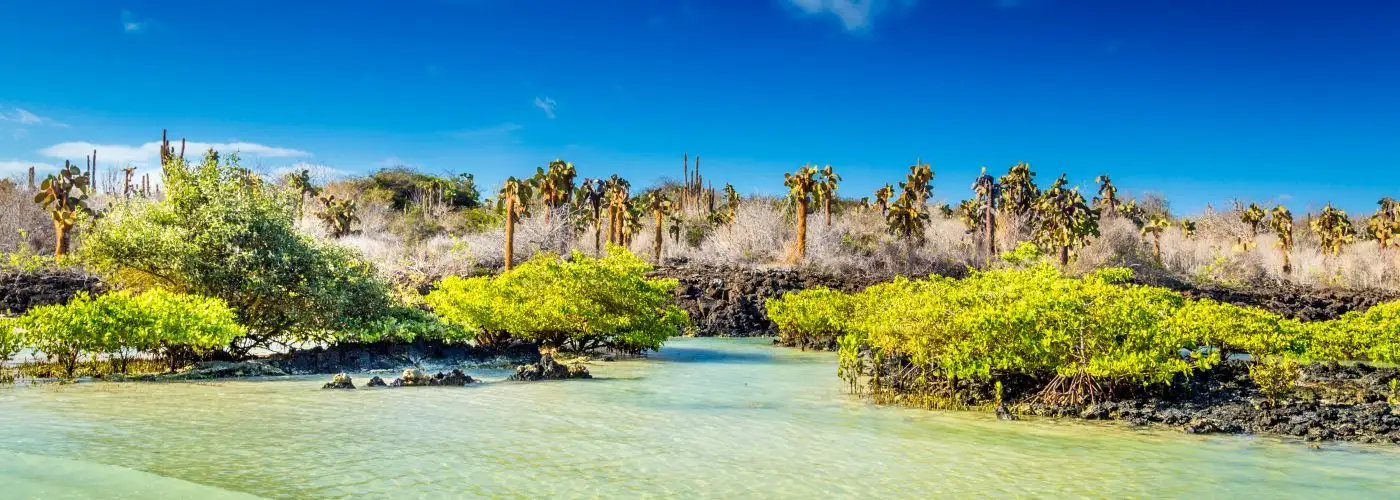The Galapagos Islands are the definition of a bucket-list destination. They’re like no other place on Earth, and you’re basically vacationing in an open zoo with some of the world’s rarest and most interesting animals. But getting to the Galapagos can be a challenge, and the tour options are overwhelming—so, how do you plan this dream trip?
I recently explored this rich archipelago on a G Adventures island-hopping tour. Here’s my island-by-island guide to both popular and lesser-known Galapagos isles.
You’ll also find other useful information, including how to get to the Galapagos, what to expect, how to pick a tour, and other advice that will help you make the most out of your Galapagos trip.
When to Go to the Galapagos
As my tour guide, Jose Valdivieso, put it, “The best time to go to Galapagos is when you decide to go.” There really is no bad time to go, because the islands’ position on the equator leads to a steady climate of sunshine and high temps.
The warm(er) and wet(ish) season lasts from January to June, with December and January seeing the highest number of tourists. The “cold” (by that I mean 80 degrees Fahrenheit and sunny) and dry season is from July to December. The biggest difference between the two seasons is the water temperature, with cooler ocean in the dry season. You’ll still be able to snorkel, swim, and dive, but you might want to bring or rent a wet suit if you’re going during these months and want to be in the water for longer periods.
Picking a Galapagos Tour
While you can technically go to the islands without a being on a tour group, I recommend going through a tour operator. You have to be accompanied by a naturalist guide certified by the Galapagos National Park Department to enter any area designated as a national park. A guide is typically included on all Galapagos tours, but make sure your tour option specifies it before you book.
In choosing a tour, look at the company’s sustainability practices. This is particularly important when traveling to the Galapagos, where the ecosystems and communities are fragile. National park rules limit the number of passengers on a cruise ship to 100 (although most boats hold under 20 people) and on-land tours to 16 people per group, so make sure your tour fits these guidelines.
Most tour companies offer marine-based trips because many of the islands are uninhabited and require snorkel sessions and offshore excursions to visit. Alternatively, you can go on an island-hopping tour where you stay at a hotel or guest house on land and focus more on hikes and guided land tours.
Both tour options have their pros and cons. Cruises allow you to travel to more islands in a shorter period of time, but when you stay on land you’re contributing more money to the local community. If you’re looking to spend more time in and on the water, a marine tour is the way to go. But if you want to do more hiking, wildlife observing, and experience Ecuadorian culture, you should go with an island-hopping tour option.
It can be tough to narrow down both the tour company and type of tour—G Adventures alone offers more than 40 different tours (28 being live-aboard marine trips) that visit the archipelago—but it’s worth the research and effort to choose the one that best fits your travel preferences and expectations.
Getting to the Galapagos
The Galapagos islands are located on both sides of the equator about 600 miles from mainland Ecuador. You can fly into Baltra or San Cristobal Island from Guayaquil or Quito. The flight is about 1.5 hours from Guayaquil and two hours from Quito. Unless you plan on touring Quito, it makes the most sense to fly directly into Guayaquil. There are direct international flights from both New York and Miami.
If you’re flying into Baltra, you board a public bus to the ferry terminal where you take a short trip across a channel to Santa Cruz Island. There you get on either a bus, private bus, or car, and head to the main town, Puerto Ayora, which is about 45 minutes away.
What to Expect in the Galapagos
Entry Requirements for the Galapagos
In order to enter the Galapagos, you will need a transit card that you purchase at either the Quito or Guayaquil airport. This costs $20 USD (U.S. dollars are the currency in Ecuador). You also need $100 in cash to pay the national park entrance fee once you arrive to the islands. This fee goes to the Ecuadorian government and the protection of the national park. As a U.S. citizen, you do not need any special visas to visit Ecuador or the islands.
Money in the Galapagos
The Galapagos are expensive in comparison to mainland Ecuador, so you will need to budget. Many tours include meals, but since ATMs are only found on three of the islands (and credit cards aren’t readily accepted), you’ll want to make sure you keep enough cash on hand for snacks or souvenirs.
If all your meals aren’t included on your tour, plan on spending $15 to $20 per meal, and more if you want an alcoholic beverage. Breakfast is included at most hotels or guest houses, and there are some markets and grocery stores that sell food for less. Most souvenirs range from $15 to $30.
Environmental Policies in the Galapagos
Since the Galapagos Islands are both a UNESCO World Heritage site and a national park, you are expected to follow environmental policies and “leave no trace.” This means using biodegradable toiletries (many hotels provide these), not flushing toilet paper down the toilet, reducing waste by carrying a water bottle, and not taking any sort of natural element (i.e. sand, coral, rocks) from any of the islands.
Your bag is checked upon entry and exit of every island, and larger bags are zip-tied closed so park rangers know they have been checked. You can read more about the national park rules here.
It is recommended that you don’t drink the tap water on the islands, but you will find filtered water tanks at most hotels and restaurants on the inhabited islands as well as aboard your ship. The islands have limited sources of freshwater, so you’ll be expected to use water wisely.
The Islands
Only four of the 13 major islands have full-time residents, so many of the smaller islands are only accessible via cruise tours or as a day trip from one of the inhabited islands. Here’s an overview of nine of the most popular islands.
Image Gallery
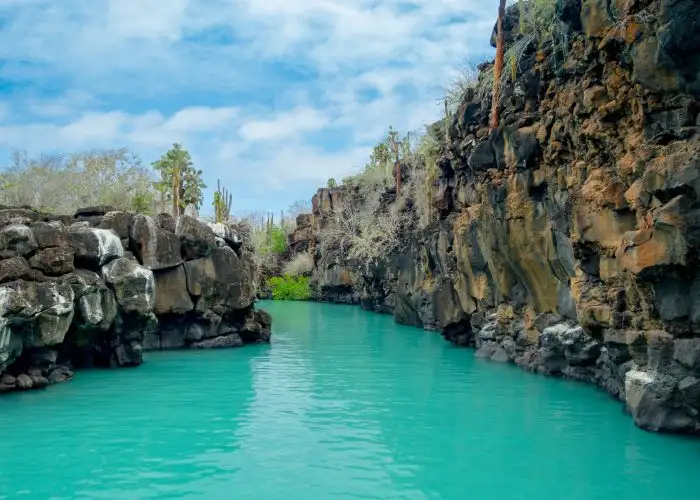
Santa Cruz is the main island in the archipelago, with the largest population at around 12,000 people. It has multiple ATMs, super markets, dozens of restaurants, and a shopping area all in the main town of Puerto Ayora. Puerto Ayora is where all visitors travel once they land at Baltra. People either stay overnight and explore the island or continue onto a cruise ship docked in the harbor.
Santa Cruz is home to the Charles Darwin Research Station, as well as beautiful natural landscapes like Las Grietas, a natural swimming hole located between two lava rock formations; and Tortuga Bay, a gorgeous white sand beach. Also check out the lava tunnels, Bachas Beach for snorkeling and swimming, Black Turtle Cove for sea life sightings, Cerro Dragon for bird watching, and Los Gemelos—the island's twin volcanic craters.

Santa Cruz is the main island in the archipelago, with the largest population at around 12,000 people. It has multiple ATMs, super markets, dozens of restaurants, and a shopping area all in the main town of Puerto Ayora. Puerto Ayora is where all visitors travel once they land at Baltra. People either stay overnight and explore the island or continue onto a cruise ship docked in the harbor.
Santa Cruz is home to the Charles Darwin Research Station, as well as beautiful natural landscapes like Las Grietas, a natural swimming hole located between two lava rock formations; and Tortuga Bay, a gorgeous white sand beach. Also check out the lava tunnels, Bachas Beach for snorkeling and swimming, Black Turtle Cove for sea life sightings, Cerro Dragon for bird watching, and Los Gemelos—the island's twin volcanic craters.
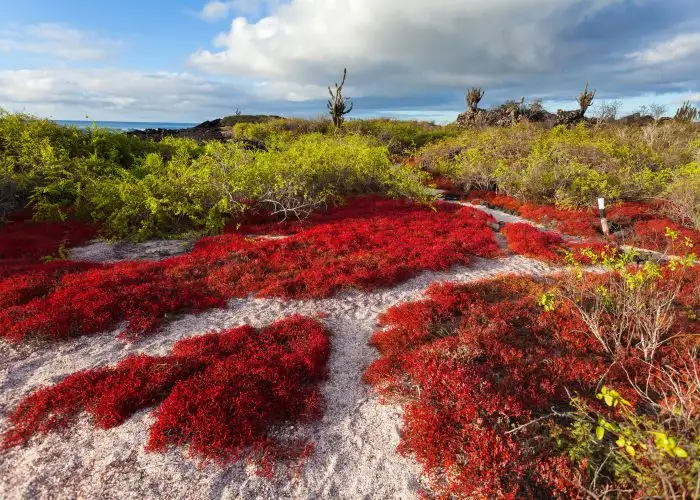
Floreana is quite the opposite of Santa Cruz, with only 150 inhabitants and a few guest houses and restaurants. To stay overnight on the island, you must travel with G Adventures or Tropic Ecuador, as they are the only two groups that coordinate with the island's community tourism program.
On Floreana, you'll experience amazing landscape, wildlife, snorkeling spots, swimming, a black sand beach, and learn about the island's mysterious history and pirate caves up in the highlands. Floreana has a unique tradition with its "Post Office," a barrel located in the main port where visitors can leave a post card addressed to themselves or someone else. The idea is that if another visitor is traveling to or lives close to the addressed person, they will hand deliver your post card to them.
If you're on a cruise ship, you likely won't visit the main town on the island, but you will snorkel at Devil's Crown and Champion Islet, and explore Cormorant Point's two beaches—one is green sand and the other is made of coral.
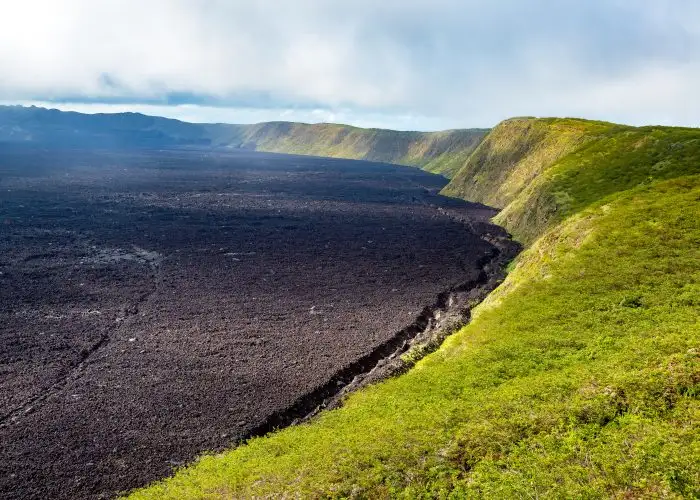
While Isabela is the largest of the islands in the Galapagos, it doesn't have as big of a population as Santa Cruz or San Cristobal. At close to 2,000 people, the island is still developing. Isabela has a different feel than Santa Cruz in that a lot of the main town is still under construction. Overall, it has a beachy vibe with a long stretch of beach right off the main town. Isabela also has incredible snorkeling, and it’s worth exploring the lava tunnel field (Tintoreras) off its coast—you can often do these both in one excursion.
Isabela is home to Sierra Negra, one of the active volcanoes—it last erupted in 2005—where you can hike to the crater. Also visit Tagus Cove, an anchorage site where you can hike for views of Darwin Lake, the bay, and Darwin and Wolf volcanoes. And, make sure to visit the Giant Tortoise Breeding Center and the flamingo feeding lagoon for some interesting wildlife. If you're interested in history, the Wall of Tears was built by the prisoners on the island when it was a penal colony from 1944 to 1959.
You'll find a decent amount of restaurants, a market, some shops, and a few ATMs here, so it's also a good place to stock up on any needed supplies.
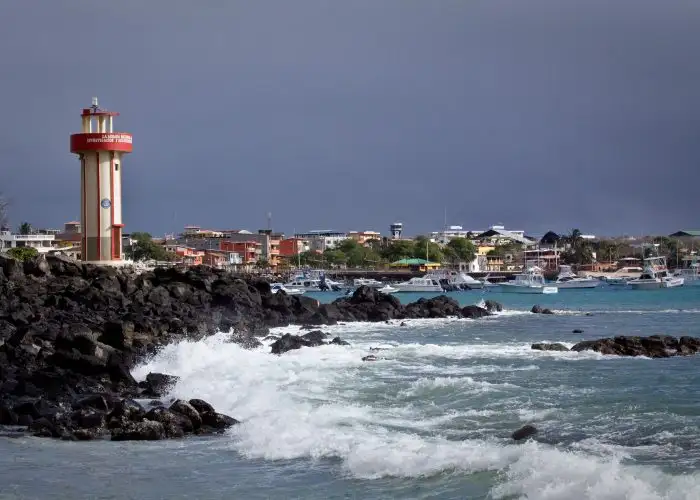
The main town in San Cristobal, Puerto Baquerizo, is the capital of the island chain and home to government offices and a university. It's also the second-largest island based on population, so you'll find restaurants, ATMs, shops, and markets.
Enjoy sea lion sightings along the coast at Cerro Brujo, visit the nearby freshwater lagoon for flamingo sightings, and stop at the tortoise breeding area in the highlands. San Cristobal has the only source of permanent fresh water found in the Galapagos--El Junco, located in the highlands.
Be sure to check out the Interpretation Center, which presents the natural and cultural history of the islands. There are also many other beach sites and coves including Isla Lobos, Ochoa Beach, Punta Pitt, Kicker Rock, Puerto Chino, and, of course, Sapho Bay, where you'll find large holes in the sand from people searching for the treasure rumored to be buried there.
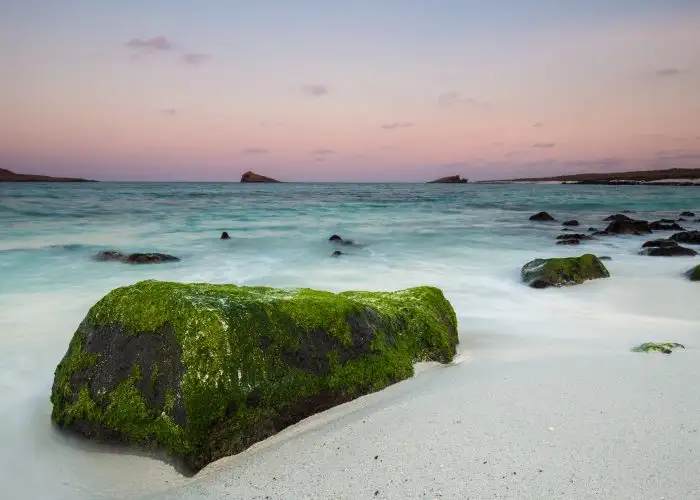
This is one of the oldest islands in the archipelago and is located far south of San Cristobal. It has a white sand beach at Garden Bay, which is home to schools of large tropical fish. The remote island has great snorkeling spots at Tortuga Rock and Garden Island, where you can spot white-tip reef sharks. Don't miss a visit to the many bird colonies at Punta Suraez, one of the richest wildlife landing sites in the archipelago.
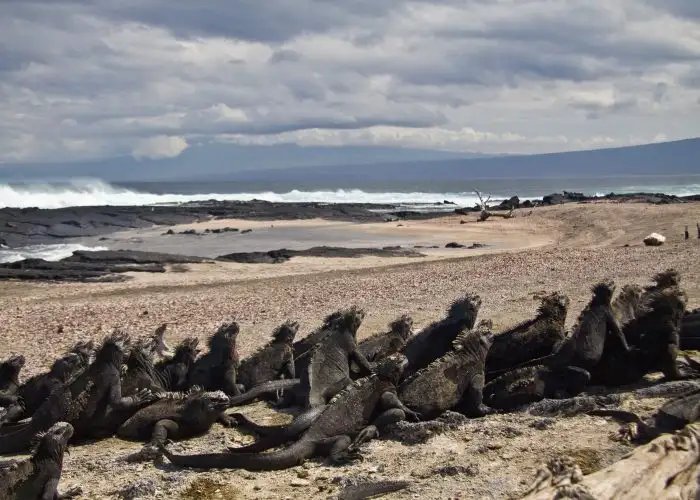
Hugging the west coast of Isabela, Fernandina is the youngest of the islands. Most notably, it's home to the rare land iguanas. You'll want to visit Urbina Bay, where you'll find dried coral in a raised marine reef that was uplifted from the water more than 50 years ago. Also visit Punta Espionza—while it's one of the least visited areas in the Galapagos, it's rich in marine iguana colonies and sea birds, and has as a beautiful beach and lava flows.
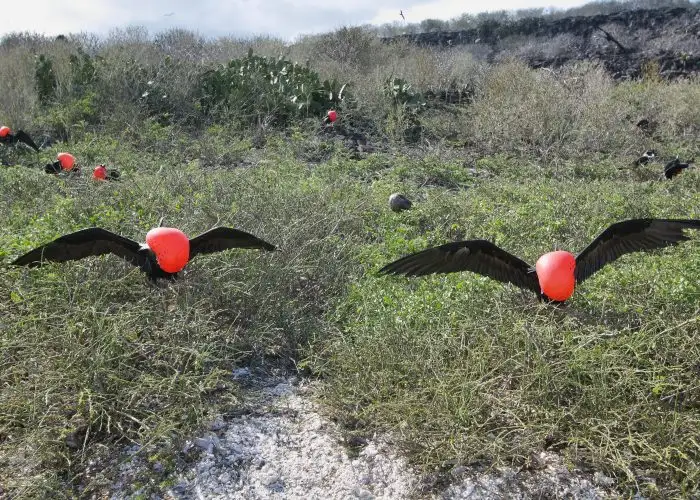
This small uninhabited island is located in the northern part of the archipelago. You'll find some of the rarest Galapagos birds here, like Red-footed Boobies, Wedge-rumped Storm Petrels, and Short-eared Owls at the Price Phillip's Steps visitor site. There is also a small white coral sand beach in Darwin Bay that has a short trail to a tidal lagoon that's home to nesting birds. Here you'll spot Lava and Swallow-tailed Gulls as you continue through Palo Santo trees—known for the mosquito-repelling aroma they give off when burned. Make sure you get to snorkel at either of these spots, as numerous shark species linger here, especially hammerheads.
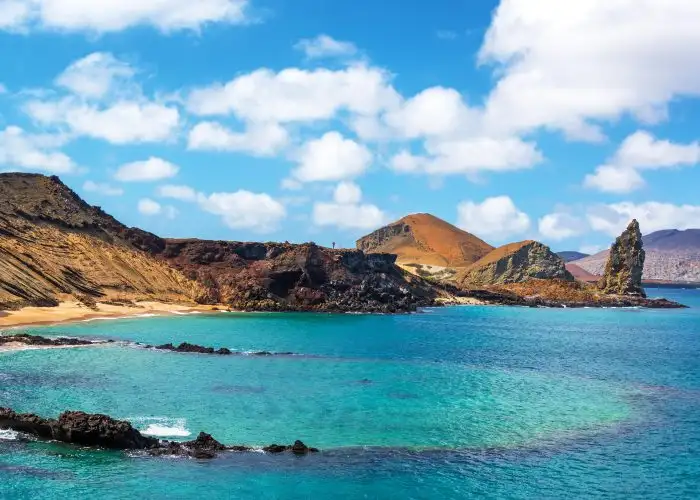
Uninhabited Bartolome is one of the smaller islands, located to the east of Santiago and north of Santa Cruz and Baltra. Here you'll find one of the most iconic rock formations in the islands—Pinnacle Rock—where you can swim and snorkel with penguins, sea lions, and sea turtles. Make sure to hike to the island's summit for panoramic views, too.
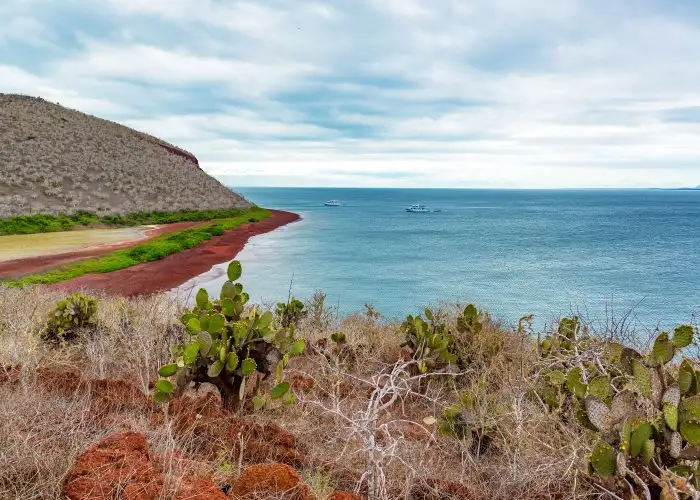
Santiago is home to one of the Galapagos’ most picturesque beaches, Playa Espumilla. Here you will find thick mangroves, along with flamingo and sea turtle nesting sites. The uninhabited island also has a salt crater, dark sand beach, snorkel spots, and tidal pools at James Bay. There’s also great snorkeling at Sullivan Bay, where you'll find giant lava formations. And, don't leave without seeing the towering cliff wall rock formations at Buccaneer Cove.
There are also two tiny islands to the south of Santiago worth exploring—Chinese Hat and Rabida. Chinese Hat is known for the snorkeling off its white-coral sand beach and Rabida has a red sand beach, pelican nesting site, and saltwater lagoon filled with Palo Santo trees.
Editor’s Note: Tourism is one of Ecuador’s main sources of income and is instrumental in helping the country recover from the earthquake in April 2016, which devastated a large part of its coast. Traveling through a sustainable tour company is a great way to donate to the country and communities affected. Or, consider making a donation here.
More from SmarterTravel:
- 10 Essential Items You Need for a Galapagos Vacation
- Discover the Galapagos in Less than 60 Seconds
- A Galapagos Cruise (in Pictures)
Ashley traveled to the Galapagos Islands courtesy of G Adventures. Follow all of her adventures (big and small) on Instagram and Twitter.
We hand-pick everything we recommend and select items through testing and reviews. Some products are sent to us free of charge with no incentive to offer a favorable review. We offer our unbiased opinions and do not accept compensation to review products. All items are in stock and prices are accurate at the time of publication. If you buy something through our links, we may earn a commission.
Related
Top Fares From
Today's Top Travel Deals
Brought to you by ShermansTravel
Shop and Save with Country Inns...
Patricia Magaña
 Hotel & Lodging Deals
Hotel & Lodging Deals
$229 -- Chicago: Discounted Rates and...
Francesca Miele
 Hotel & Lodging Deals
$229+
Hotel & Lodging Deals
$229+
$188 -- Honolulu: Save on Oceanview...
Abigail Lamay
 Hotel & Lodging Deals
$188+
Hotel & Lodging Deals
$188+
